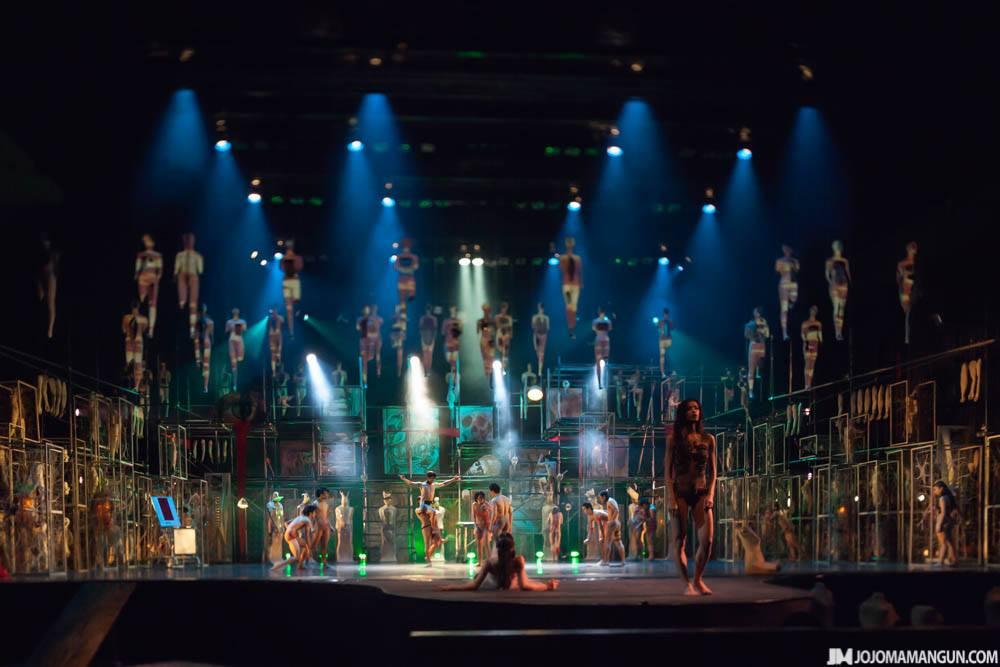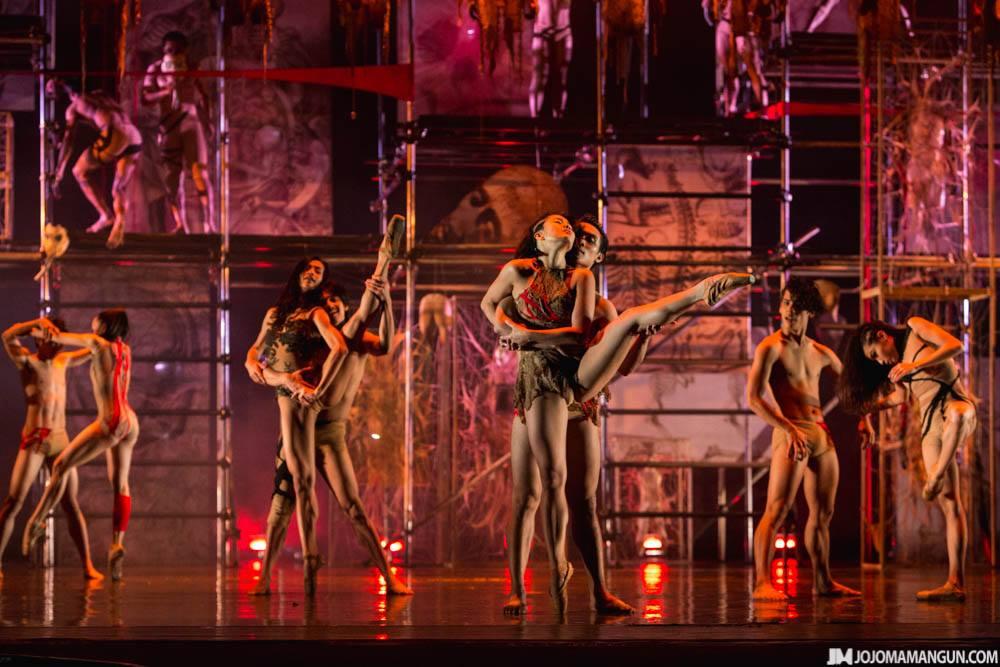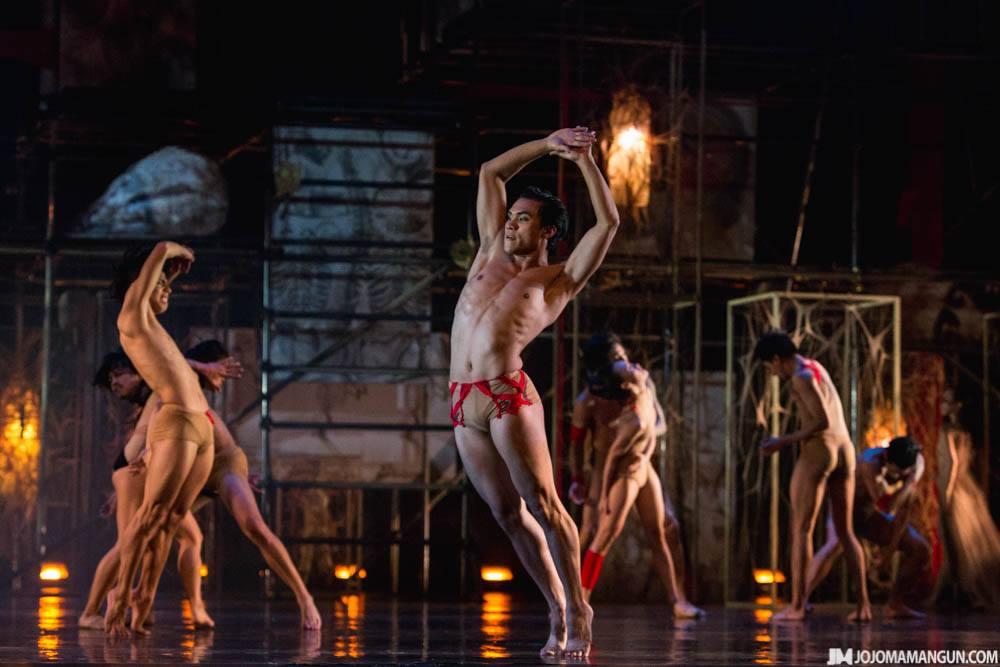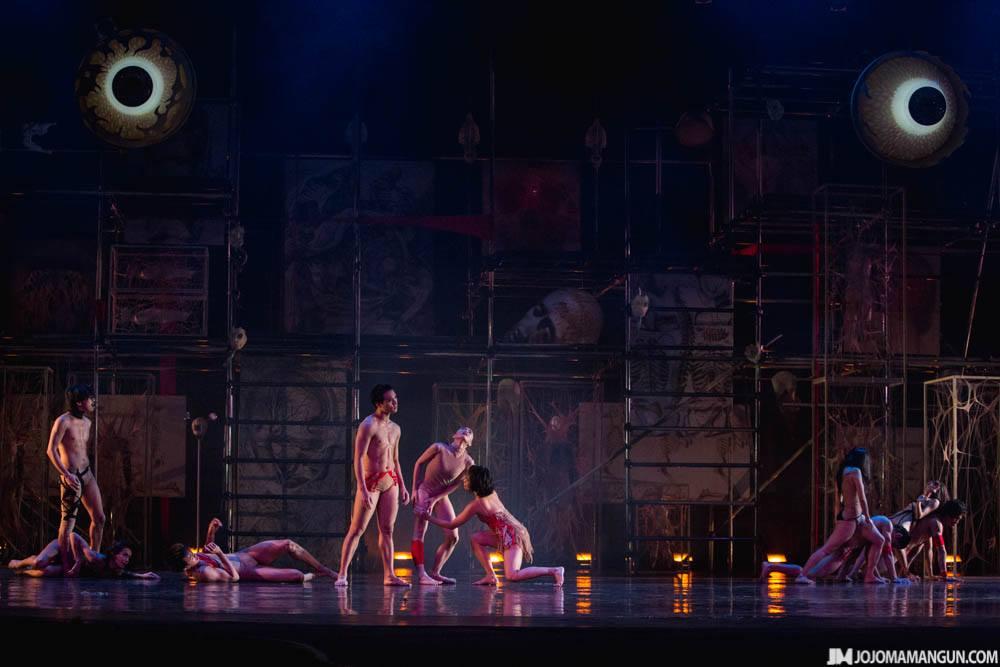Sculpture and movement tell a tale of life and death, love and rebirth in ‘Opera’

Ballet Philippines closed its 46th season on Tuesday with a brilliant production with a long title, “Gabriel Barredo’s Opera, Choreographed by Redha.”
In its earlier form, the title was listed as simply as “Opera: A Rebirth in Arabesque.”
The word “Opera” in the original working title referred to Barredo’s art works and installations, which were first exhibited at the Silverlens art galleries in January 2015 and toured Singapore in November 2015 as part of the opening of the National Gallery Singapore.
On the other hand, “arabesque,” a term used often in ballet and various dance forms, describes “a position where the body is supported on one leg, with the other leg extended directly behind the body with a straight knee, and the standing leg can be straight or in plie, but the back leg must always be straight.”
Watching “Opera” the first time close to the proscenium of the stage was already a thrilling experience. Viewing it for the second time, from a distance to get a panoramic view of the production, was a compelling 90 minutes of suspenseful drama and total tension.

After watching “Opera” twice, one understands why the name of Filipino installation artist Barredo, who is also stage designer for the production, and that of French-Algerian choreographer Redha Beintefour must be included in the title of the season-ender.
BP’s “Opera” is a contemporary ballet that dissolved the undulating borders of Barredo’s 400 pieces of art works and installations and Redha’s emotional interpretation of them via motion and movements.
Towering installations
One enters the majestic and cavernous Main Theater Lobby of the Cultural Center of the Philippines only to be captured and captivated by the towering Barredo installations on display throughout the lobby and the hallways. One is intrigued if not dazzled by these Barredo creations: according to one Silverlens official in a backstage interview after the Sunday performance, almost all of the art works and installations displayed in the lobby and used for the stage design were specifically created for the three-night run.
The collection, notably the pieces and installations which decorated the stage, is an arresting assembly of colorful site-specific works and huge moving sculptures of the human anatomy.
Subtly, the mammoth production design evoked the atmosphere of a Victorian operating theater, with one crucial scene even featuring an operating table.
Four hundred monumental Barredo pieces were showcased throughout three acts, remarkably without overpowering the BP dancers, who were always the center of the performance. This was done by suspending the art works via different “sceneries” flown in and out of the stage.
Return of Redha
Distinctly remembered for his sharp and ingenious choreography in past BP productions such as “Je, Tu, Elle” and “Les Petits Mots d’Amour” many seasons ago, Redha was the first and only choice to choreograph the production.
Before coming to Manila, Redha collaborated with the Bolshoi Ballet, the Alvin Ailey American Dance Theater, The National Ballet of Cuba, Le Jeune Ballet de France, The Het Nationale Ballet, and the San Francisco Ballet.
He described both the act of seeing the spectacular Barredo art works and watching the staggering “Opera” ballet production as “a journey of discovering, simply flowing with, and experiencing contemporary Filipino ballet, music, and visual arts.”

A mother's love
“Opera” is the story of a mother and her twins living in a world of creations and temptations. Their existence is disturbed by the arrival of The Watcher (Jean Marc Cordero), who seduces and snatches one of the twins. To save her children, The Mother (Carissa Adea) agrees to dance with Death (Denise Parungao) and in the process gives away her heart to the Homunculus (Earl John Arisola) in a supreme act of love to reunite The Twins (Victor Maguad and Erl Sorilla) and to heal the world.
Completing the ensemble were Timothy Paul Cabrera, Garry Corpuz, Katrene San Miguel, and Louise John Ababon as the Imperfect Creations and Cyril Aran Fallar, Rita Angela Winder, Christopher Nino Royeca, Jemima Reyes, Janine Myrtel Arisola, Lester John Reguindin, Danilo Dayo Jr., and Mark Anthony Grantos as The Watcher’s Eyes.
All the dancers, from the principal to the soloists to the ballet corps, showed powerful stage presence, from the foreboding entry of Death to The Mother giving birth to The Twins to the final scene.

Three Acts
Act One (God) may be impenetrable initially because it appeared dark and abstract and the pace of choreography was slow, but it contained ample theatrical steam to make the audience return to their seats for the Second Act after the 15-minute intermission.
Dancers bathed in light, dancing with energetic yet sinuous twists and turns as if simulating an orgy, made Act Two (Sex) explode. Against the backdrop of the sound of heavy breathing and heart beating, Act Two was highlighted by angular and highly stylized body movements. Of the three acts, Act Two was supreme for its dynamic and impressive choreography.
However, it was in Act Three (Death) that Redha demonstrated his sense of theatricality and mastery of narrating stories through body movements.
Act Three was predominantly lighted by John Batalla in red symbolizing the twins’ blood relations, that they came from the same womb despite what happened to them.
Red was also the color of the stage when The Mother gave her heart to The Homonculus to save her twins and the entire world of creations. And the rebirth of the world and the reunification of the twins were marked with red shades.
Redha admirably and skillfully interpreted the spirit, intent, symbolism, and text in the libretto written by Yvette Tan and Erwin Romulo. Their successful metamorphosis into movement is among the strongest points of this production.
Amid the majesty of Barredo’s works, Redha’s dance choreography took the center stage, for ballet is about dance and dancing. His associate choreographer must also be given credit for the production's success.
The music, composed by Malek Lopez and performed live by Caliph8, Fred Sandoval, Erwin Romulo, and Armi Millare, added an incomparable sensation and a disconcerting, if not disturbing, background to the production. And very newness of this disconcerting music, not previously associated with ballet but now accompanying a contemporary ballet, is an unprecedented achievement for Philippine ballet.

Light and color
"Opera" was delectably and beautifully lit by John Batalla, who said that careful planning and execution were made to amply light the sculptures and at the same time highlight and focus the dancers—dressed magnificently by James Reyes—without them being gobbled by the set.
Batalla skillfully worked around the challenges posed by Barredo's use of lighting within some of his pieces (both incandescent bulbs and LEDs were placed inside the mannequins, which added punch to the lighting design).
The team agreed to bathe the set in saturated red, blue, green, and amber to break the dance into its primary acts. Meanwhile, the dancers were enveloped by a spray of cool and clinical white lights.
Batalla and his team experimented and played around with lights and created stripes of light on the stage floor where dancers can weave in and out of the dark and bright spots.
Again, the gifts of Batalla and his men were wonderfully showcased in "Opera".
The video clips created by Film Pabrika added flavor to the total production design. — BM, GMA News
Ballet Philippines' "Opera" was performed on February 13, 14 and 16 at the Cultural Center of the Philippines' Tanghalang Nicanor Abelardo.




